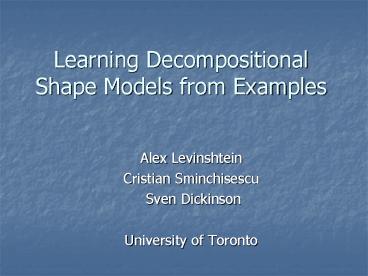Learning Decompositional Shape Models from Examples - PowerPoint PPT Presentation
Title:
Learning Decompositional Shape Models from Examples
Description:
Title: Learning Decompositional Models from Examples Author: Alex Last modified by: Alex Created Date: 11/4/2004 10:56:19 PM Document presentation format – PowerPoint PPT presentation
Number of Views:105
Avg rating:3.0/5.0
Title: Learning Decompositional Shape Models from Examples
1
Learning Decompositional Shape Models from
Examples
- Alex Levinshtein
- Cristian Sminchisescu
- Sven Dickinson
- University of Toronto
2
Hierarchical Models
Manually built hierarchical model proposed by
Marr And Nishihara (Representation and
recognition of the spatial organization of three
dimensional shapes, Proc. of Royal Soc. of
London, 1978)
3
Our goal
Automatically construct a generic hierarchical
shape model from exemplars
- Challenges
- Cannot assume similar appearance among different
exemplars - Generic features are highly ambiguous
- Generic features may not be in one-to-one
correspondence
4
Appearance-based models
Automatically built appearance-based model from
video sequence (Ramanan, D. and Forsyth, D.A.,
Using Temporal Coherence to Build Models of
Animals, ICCV, 2003)
5
Layered Motion Segmentations Kumar, Torr and
Zisserman, ICCV 2005
- Models image projection, lighting and motion blur
- Models spatial continuity, occlusions, and works
over multiple frames (cf. earlier work by Jojic
Frey, CVPR 2001) - Estimates the number of segments, their mattes,
layer assignment, appearance, lighting and
transformation parameters for each segment - Initialization using loopy BP, refinement using
graph cuts
6
Constellation models
Fergus, R., Perona, P., and Zisserman, A.,
Object Class Recognition by Unsupervised
Scale-Invariant Learning, CVPR 2003
7
Categorical features
Match
8
Automatically constructed Hierarchical Models
Input
Question What is it?
Output
9
Stages of the system
Exemplar images
Extract Blob Graphs
Blob graphs
Match Blob Graphs (many-to-many)
Many-to-many correspondences
Extract Parts
Extract Decomposition Relations
Extract Attachment Relations
Model parts
Model decomposition relations
Model attachment relations
Assemble Final Model
10
Blob Graph Construction
Exemplar images
Extract Blob Graphs
Blob graphs
Match Blob Graphs (many-to-many)
Many-to-many correspondences
Extract Parts
Extract Decomposition Relations
Extract Attachment Relations
Model parts
Model decomposition relations
Model attachment relations
Assemble Final Model
11
Blob Graph Construction
On the Representation and Matching of Qualitative
Shape at Multiple Scales A. Shokoufandeh, S.
Dickinson, C. Jonsson, L. Bretzner, and T.
Lindeberg,ECCV 2002
- Edges are invariant to articulation
- Choose the largest connected component.
12
Blob Graph Construction
Perceptual grouping of blobs
Connectivity measure maxd1/major(A),
d2/major(B)
13
Feature matching
Exemplar images
Extract Blob Graphs
Blob graphs
Match Blob Graphs (many-to-many)
Many-to-many correspondences
Extract Parts
Extract Decomposition Relations
Extract Attachment Relations
Model parts
Model decomposition relations
Model attachment relations
Assemble Final Model
14
Feature matching
One-to-one matching. Rely on shape and context,
not appearance!
Many-to-many matching
15
A Many-to-Many Graph Matching Framework
1. Embed graphs with low distortion to yield
weighted point distributions. 2. Compute
many-to-many correspondences between the two
distributions using EMD. 3. The computed flows
yield a many-to-many node correspondence between
the two graphs.
Demirci, Shokoufandeh, Dickinson, Keselman, and
Bretzner (ECCV 2004)
16
Feature embedding and EMD
Spectral embedding
17
Returning to our set of inputs
- Many-to-many matching of every pair of exemplars.
18
Part Extraction
Exemplar images
Extract Blob Graphs
Blob graphs
Match Blob Graphs (many-to-many)
Many-to-many correspondences
Extract Parts
Extract Decomposition Relations
Extract Attachment Relations
Model parts
Model decomposition relations
Model attachment relations
Assemble Final Model
19
Many-to-many matching results
100
100
100
50 50
20
Extracting parts
- Part a collection of blobs.
- Ideal part
- All blobs are from different exemplars
- All blobs in a part match one to one
- Finding parts
- Cluster large collections of blobs (preferably
from different exemplars), most of which match
one to one.
21
(No Transcript)
22
Results of the part extraction stage
23
What is next?
24
Extracting attachment relations
Exemplar images
Extract Blob Graphs
Blob graphs
Match Blob Graphs (many-to-many)
Many-to-many correspondences
Extract Parts
Extract Decomposition Relations
Extract Attachment Relations
Model parts
Model decomposition relations
Model attachment relations
Assemble Final Model
25
Extracting attachment relations
Number of times blobs drawn from the two clusters
were attached
is high
Right arm is typically connected to torso in
exemplar images !
Number of times blobs from the two clusters
co-appeared in an image.
Torso
Right Arm
26
Extracting decomposition relations
Exemplar images
Extract Blob Graphs
Blob graphs
Match Blob Graphs (many-to-many)
Many-to-many correspondences
Extract Parts
Extract Decomposition Relations
Extract Attachment Relations
Model parts
Model decomposition relations
Model attachment relations
Assemble Final Model
27
Extracting decomposition relations
Left Arm
Upper
Lower
28
Model construction stage summary
Model Construction
- Clustering blobs into parts based on one-to-one
matching results. - Recovering relations between parts based on
individual matching and attachment results.
29
Assemble Final Model
Exemplar images
Extract Blob Graphs
Blob graphs
Match Blob Graphs (many-to-many)
Many-to-many correspondences
Extract Parts
Extract Decomposition Relations
Extract Attachment Relations
Model parts
Model decomposition relations
Model attachment relations
Assemble Final Model
30
Results
31
(No Transcript)
32
(No Transcript)
33
Conclusions
- Generic models must be defined at multiple levels
of abstraction, as Marr proposed. - Coarse shape features, such as blobs, are highly
ambiguous and cannot be matched without
contextual constraints. - Moreover, features that exist at different levels
of abstraction must be matched many-to-many in
the presence of noise. - The many-to-many matching results can be analyzed
to yield both the parts and relations of a
decompositional model. - Preliminary results indicate that a limited
decompositional model can be learned from a set
of noisy examples.
34
Future work
- Construct models for objects other than humans
objects with richer decompositional hierarchies. - Automatically learn perceptual grouping relations
between blobs from labeled examples. - Develop indexing and matching frameworks for
decompositional models.



























![Investigations on Automatic Behavior-based System Design [A Survey on] Hierarchical Reinforcement Learning PowerPoint PPT Presentation](https://s3.amazonaws.com/images.powershow.com/6219810.th0.jpg?_=20150306026)



